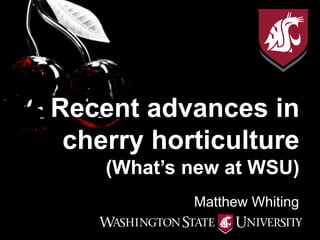StoneFruitDay_Wenatchee 20 January, 2015
- 1. Matthew Whiting Recent advances in cherry horticulture (WhatŌĆÖs new at WSU)
- 2. Output vs. Input: OUTPUT INPUT LO/LO HI/LO HI/HI LO/HI Production systems
- 3. Innovations in cherry production ŌĆó Genetic ŌĆó Orchard systems ŌĆó Automation/mechanization ŌĆō Mechanical pruning ŌĆō Mechanical harvest ŌĆó Precision management ŌĆó Plant growth regulators
- 4. Current orchard systemsFuture orchard systems
- 5. Pruning rules: 1.Remove all lateral wood (leave short stubs) 2.Renew vigorous uprights (leave renewal sites) Simplified Pruning of the UFO System:
- 6. Mechanical pruning ŌĆó Simplified planar systems ŌĆō simplify pruning ŌĆó Investigated potential for mechanical pruning in UFO since 2010
- 7. ŌĆó Collard system ŌĆó 7 (vertical) or 4 (horizontal) circular saw blades ŌĆó 6-th leaf UFO ŌĆó Hand vs. Mech. Vs. Mech + hand Mechanical pruning
- 8. CONCLUSIONS Hand pruning 2 min 40 s per tree (1800 trees/ha = 80 hr/ha) Full mechanical pruning: ’āś 12.5-times faster (6.5 hr/ha) ’āś Removed ca. 60% less wood than hand pruning Mechanical + hand pruning: ’āś 25% faster than hand pruning ’āś Same amount of wood removed as hand pruning Good potential to reduce pruning time/costs using mechanical systems.
- 9. Objective Determine best management practices for pruning sweet cherry and apple mechanically, by understanding equipment and orchard requirements.
- 10. Mechanical pruning ŌĆó GillisonŌĆÖs GVF Center Mount Topper and Hedger ŌĆó Side shift ca. 1 .2 m on either side of the tractor ŌĆó Height adjustment of 1 m to 6.5 m ŌĆó 360┬░ rotation of cutting head
- 11. Experiment outline Apple Mechanical pruning vs. hand pruning Sweet cherry Mechanical hedging and topping vs/+ hand pruning Pre/postharvest topping
- 12. Sweet cherry trials: Trial block details Variety Tieton Rootstock ŌĆśGisela ┬«5ŌĆÖ Training system UFO Tree age 8th leaf Tree spacing 2.5 x 3.1 m
- 13. Trial design: 3 treatments x 5 reps ŌĆó 20 trees/rep ŌĆó Completely randomized design ŌĆó Post-harvest hedging and topping Mechanical pruning vs. Hand pruning YEAR 1 1. Hand pruning 2. Mechanical pruning (1) 3. Mechanical pruning (2) YEAR 2 1. Hand pruning 2. Mechanical pruning 3. Mechanical pruning + Hand pruning
- 14. Data collection ŌĆó Time to prune ŌĆó Performance of the machine ŌĆó Weight wood pruned ŌĆó Wood damage ŌĆó Economic evaluation
- 15. Preliminary results (2014) ŌĆó Hand pruning removed 2 x wood removed than mechanical pruning ŌĆó Hand pruning 10 kg/tree ŌĆó Mechanical pruning 5 kg/tree ŌĆó ŌĆ£Dirty cutsŌĆØ 0 0.01 0.02 0.03 0.04 0.05 0.06 0.07 Hand pruning Mechanical pruning Kg/cm2 Wood pruned
- 16. Results - Time ŌĆó Mechanical pruning 23 x faster than hand pruning (hedging and topping) ŌĆó Hand pruning 374 sec/tree 6 min/tree ŌĆó Mechanical pruning 16 sec/tree 0.3 min/tree ŌĆó Tractor speed: 1.9 km/h 0 20 40 60 80 100 120 140 Mechanical pruning Hand pruning Time/rep(min)
- 17. Topping
- 18. Hedging
- 19. Example ŌĆó Sweet cherry orchard trained to UFO training system ŌĆó Spacing: 2 m x 3.1 m ŌĆó 8 h work/day ŌĆó Mechanical pruning: ŌĆó 2.5 h/ac ŌĆó 3.2 ac/day ŌĆó Hand pruning: ŌĆó 55 h/ac ŌĆó 0.14 ac/day
- 20. Mechanical pollination ŌĆó Colony collapse disorder, variable environmental conditions, poor bloom overlap, insufficient pollenizers/pollinators all threaten ability to set a crop For yield security and resilience to: 8.2 t/ha
- 21. Proposed solution: ŌĆó Collect pollen ŌĆó Suspend pollen ŌĆó Apply pollen via sprayer ŌĆó Challenges: ŌĆō Stigma is a small target! ŌĆō Pollen loses viability in liquid
- 23. Mechanical pollination ŌĆśTietonŌĆÖ/ ŌĆśGisela 5ŌĆÖ: 8 years old trained to UFO
- 25. Mechanical pollination a b ŌĆó Proof of concept study ŌĆó Supplemental pollination ŌĆó Sprayed pollen once at 50% bloom ŌĆó Fruit set improved 15% ŌĆó Increased pollen deposition
- 26. Mechanical pollination ŌĆó Proof of concept study ŌĆó Replacement pollination ŌĆó Sprayed pollen through bee exclusion netting ŌĆó Two applications (50% and 90% ) ŌĆó Yield similar to open-pollinated trees a b 0 1 2 3 4 5 6 7 Control Treated Fruityield(kg/tree)
- 27. Mechanical pollination 0% 10% 20% 30% 40% 50% 60% 70% 80% 90% Treated Control Fruitset(%) a b Mechanical shaking to transfer pollen Self-fertile cultivars
- 28. Mechanical harvest ŌĆó Harvest costs are >50% of all ŌĆó Labor cost increasing ŌĆó Labor availability decreasing
- 29. Mechanical harvest ŌĆó Taking short- and long-term approach using total systems approach ŌĆō Mechanical assist (shake-and-catch) ŌĆō Fully mechanical harvest
- 30. In domestic and export markets, stem-free cherries are accepted/preferred
- 31. New packaging + marketing by Chelan Fresh
- 32. Plant growth regulators ŌĆó Post-bloom thinning ŌĆó AVG for improving fruit set
- 33. ŌĆśKordiaŌĆÖ in Tasmania Treatment Fruit set (%) Fruit wt (g) Cracked fruit (%) Control 9.7 a 14.5 b 25.1 b AVG 500 g/ha 15.3 b 12.9 a 14.0 a (ca. ┬Š pouch/ac) Rate of AVG ns ns ns Time of application ns ns ns Collaboration with Dugald Close, Sally Bound; UTas Increasing fruit set
- 34. Rate and timing studies ŌĆó Rates: ŌĆō 0, 0.5, 1.0, 1.5 pouches/acre ŌĆō 0, 166, 333, 500 g/ac ŌĆó Timings: ŌĆō Popcorn, 10% FB, 50% FB, ca. FB Pacific Northwest, 2013
- 35. ŌĆśReginaŌĆÖ in Zillah 0% 5% 10% 15% 20% 25% 30% 35% 40% 45% 50% Control 0.5 AVG 1.0 AVG 1.5 AVG 10%fullbloom 10%fullbloom 10%fullbloom popcorn 50%fullbloom fullbloom Fruit set - % available flowers 1.0 AVG
- 36. 0 5 10 15 20 25 30 35 Control Retain: 30 % FB Retain: 65 % FB Retain: 30 & 65 % FB FruitSet(%) AVG Improves ŌĆśReginaŌĆÖ Fruit Set ŌĆó Surfactant’āĀ 0.1% v:v ŌĆó Rate’āĀ 1 pouch per ac ŌĆó Timing between 10 to 80% of full bloom Data from Todd Einhorn, OSU
- 37. Recommendations: ŌĆó ReTain┬« applied at 10% to full bloom ŌĆó 333 g per acre ŌĆó Single application ŌĆó Particularly during warm weather





































